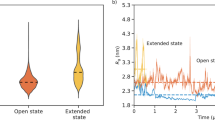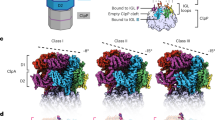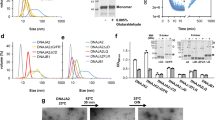Abstract
The HtrA protein family combines chaperone and protease activities and is essential for protein quality control in many organisms. Whereas the mechanisms underlying the proteolytic function of HtrA proteins are well characterized, their chaperone activity remains poorly understood. Here we describe cryo-EM structures of Escherichia coli DegQ in its 12- and 24-mer states in complex with model substrates, providing a structural model of HtrA chaperone action. Up to six lysozyme substrates bind inside the DegQ 12-mer cage and are visualized in a close-to-native state. An asymmetric reconstruction reveals the binding of a well-ordered lysozyme to four DegQ protomers. DegQ PDZ domains are located adjacent to substrate density and their presence is required for chaperone activity. The substrate-interacting regions appear conserved in 12- and 24-mer cages, suggesting a common mechanism of chaperone function.
This is a preview of subscription content, access via your institution
Access options
Subscribe to this journal
Receive 12 print issues and online access
$189.00 per year
only $15.75 per issue
Buy this article
- Purchase on Springer Link
- Instant access to full article PDF
Prices may be subject to local taxes which are calculated during checkout





Similar content being viewed by others
References
Gottesman, S., Wickner, S. & Maurizi, M.R. Protein quality control: triage by chaperones and proteases. Genes Dev. 11, 815–823 (1997).
Wickner, S., Maurizi, M.R. & Gottesman, S. Posttranslational quality control: folding, refolding, and degrading proteins. Science 286, 1888–1893 (1999).
Selkoe, D.J. Folding proteins in fatal ways. Nature 426, 900–904 (2003).
Clausen, T., Kaiser, M., Huber, R. & Ehrmann, M. HTRA proteases: regulated proteolysis in protein quality control. Nat. Rev. Mol. Cell Biol. 12, 152–162 (2011).
Chien, J., Campioni, M., Shridhar, V. & Baldi, A. HtrA serine proteases as potential therapeutic targets in cancer. Curr. Cancer Drug Targets 9, 451–468 (2009).
Grau, S. et al. Implications of the serine protease HtrA1 in amyloid precursor protein processing. Proc. Natl. Acad. Sci. USA 102, 6021–6026 (2005).
Plun-Favreau, H. et al. The mitochondrial protease HtrA2 is regulated by Parkinson's disease-associated kinase PINK1. Nat. Cell Biol. 9, 1243–1252 (2007).
Ingmer, H. & Brondsted, L. Proteases in bacterial pathogenesis. Res. Microbiol. 160, 704–710 (2009).
Krojer, T. et al. Structural basis for the regulated protease and chaperone function of DegP. Nature 453, 885–890 (2008).
Sawa, J. et al. Molecular adaptation of the DegQ protease to exert protein quality control in the bacterial cell envelope. J. Biol. Chem. 286, 30680–30690 (2011).
Spiess, C., Beil, A. & Ehrmann, M. A temperature-dependent switch from chaperone to protease in a widely conserved heat shock protein. Cell 97, 339–347 (1999).
Walsh, N.P., Alba, B.M., Bose, B., Gross, C.A. & Sauer, R.T. OMP peptide signals initiate the envelope-stress response by activating DegS protease through relief of inhibition mediated by its PDZ domain. Cell 113, 61–71 (2003).
Wilken, C., Kitzing, K., Kurzbauer, R., Ehrmann, M. & Clausen, T. Crystal structure of the DegS stress sensor: How a PDZ domain recognizes misfolded protein and activates a protease. Cell 117, 483–494 (2004).
Kim, D.Y. & Kim, K.K. Structure and function of HtrA family proteins, the key players in protein quality control. J. Biochem. Mol. Biol. 38, 266–274 (2005).
Li, W. et al. Structural insights into the pro-apoptotic function of mitochondrial serine protease HtrA2/Omi. Nat. Struct. Biol. 9, 436–441 (2002).
Truebestein, L. et al. Substrate-induced remodeling of the active site regulates human HTRA1 activity. Nat. Struct. Mol. Biol. 18, 386–388 (2011).
Jiang, J. et al. Activation of DegP chaperone-protease through formation of large cage-like oligomers upon binding to substrate proteins. Proc. Natl. Acad. Sci. USA 105, 11939–11944 (2008).
Kim, S., Grant, R.A. & Sauer, R.T. Covalent linkage of distinct substrate degrons controls assembly and disassembly of DegP proteolytic cages. Cell 145, 67–78 (2011).
Krojer, T., Garrido-Franco, M., Huber, R., Ehrmann, M. & Clausen, T. Crystal structure of DegP (HtrA) reveals a new protease-chaperone machine. Nature 416, 455–459 (2002).
Shen, Q.T. et al. Bowl-shaped oligomeric structures on membranes as DegP's new functional forms in protein quality control. Proc. Natl. Acad. Sci. USA 106, 4858–4863 (2009).
Wrase, R., Scott, H., Hilgenfeld, R. & Hansen, G. The Legionella HtrA homologue DegQ is a self-compartmentizing protease that forms large 12-meric assemblies. Proc. Natl. Acad. Sci. USA 108, 10490–10495 (2011).
Merdanovic, M. et al. Determinants of structural and functional plasticity of a widely conserved protease chaperone complex. Nat. Struct. Mol. Biol. 17, 837–843 (2010).
Topf, M. et al. Protein structure fitting and refinement guided by cryo-EM density. Structure 16, 295–307 (2008).
Krojer, T., Sawa, J., Huber, R. & Clausen, T. HtrA proteases have a conserved activation mechanism that can be triggered by distinct molecular cues. Nat. Struct. Mol. Biol. 17, 844–852 (2010).
Aquilina, J.A., Benesch, J.L., Bateman, O.A., Slingsby, C. & Robinson, C.V. Polydispersity of a mammalian chaperone: mass spectrometry reveals the population of oligomers in alphaB-crystallin. Proc. Natl. Acad. Sci. USA 100, 10611–10616 (2003).
McCammon, M.G., Hernandez, H., Sobott, F. & Robinson, C.V. Tandem mass spectrometry defines the stoichiometry and quaternary structural arrangement of tryptophan molecules in the multiprotein complex TRAP. J. Am. Chem. Soc. 126, 5950–5951 (2004).
Sharon, M. et al. 20S proteasomes have the potential to keep substrates in store for continual degradation. J. Biol. Chem. 281, 9569–9575 (2006).
Sobott, F., Hernandez, H., McCammon, M.G., Tito, M.A. & Robinson, C.V. A tandem mass spectrometer for improved transmission and analysis of large macromolecular assemblies. Anal. Chem. 74, 1402–1407 (2002).
Itzhaki, L.S., Evans, P.A., Dobson, C.M. & Radford, S.E. Tertiary interactions in the folding pathway of hen lysozyme: kinetic studies using fluorescent probes. Biochemistry 33, 5212–5220 (1994).
Lin, J.L., Ruaan, R.C. & Hsieh, H.J. Refolding of partially and fully denatured lysozymes. Biotechnol. Lett. 29, 723–729 (2007).
Clare, D.K., Bakkes, P.J., van Heerikhuizen, H., van der Vies, S.M. & Saibil, H.R. Chaperonin complex with a newly folded protein encapsulated in the folding chamber. Nature 457, 107–110 (2009).
Muñoz, I.G. et al. Crystal structure of the open conformation of the mammalian chaperonin CCT in complex with tubulin. Nat. Struct. Mol. Biol. 18, 14–19 (2011).
Volokhina, E.B. et al. Role of the periplasmic chaperones Skp, SurA, and DegQ in outer membrane protein biogenesis in Neisseria meningitidis. J. Bacteriol. 193, 1612–1621 (2011).
Sawa, J. et al. Molecular adaptation of the DegQ protease to exert protein quality control in the bacterial cell envelope. J. Biol. Chem. 286, 30680–30690 (2011).
Crowther, R.A., Henderson, R. & Smith, J.M. MRC image processing programs. J. Struct. Biol. 116, 9–16 (1996).
Ludtke, S.J., Baldwin, P.R. & Chiu, W. EMAN: semiautomated software for high-resolution single-particle reconstructions. J. Struct. Biol. 128, 82–97 (1999).
Mindell, J.A. & Grigorieff, N. Accurate determination of local defocus and specimen tilt in electron microscopy. J. Struct. Biol. 142, 334–347 (2003).
Frank, J. et al. SPIDER and WEB: processing and visualization of images in 3D electron microscopy and related fields. J. Struct. Biol. 116, 190–199 (1996).
van Heel, M., Harauz, G., Orlova, E.V., Schmidt, R. & Schatz, M. A new generation of the IMAGIC image processing system. J. Struct. Biol. 116, 17–24 (1996).
Sali, A. Comparative protein modeling by satisfaction of spatial restraints. Mol. Med. Today 1, 270–277 (1995).
Krojer, T. et al. Structural basis for the regulated protease and chaperone function of DegP. Nature 453, 885–890 (2008).
Goddard, T.D., Huang, C.C. & Ferrin, T.E. Visualizing density maps with UCSF Chimera. J. Struct. Biol. 157, 281–287 (2007).
Topf, M. et al. Protein structure fitting and refinement guided by cryo-EM density. Structure 16, 295–307 (2008).
Pringle, S.D. et al. An investigation of the mobility separation of some peptide and protein ions using a new hybrid quadrupole/travelling wave IMS/oa-ToF instrument. Int. J. Mass Spectrom. 261, 1–12 (2007).
Tito, M.A., Tars, K., Valegard, K., Hajdu, J. & Robinson, C.V. Electrospray time of flight mass spectrometry of the intact MS2 virus capsid. J. Am. Chem. Soc. 122, 3550–3551 (2000).
Spiess, C. et al. Biochemical characterization and mass spectrometric disulfide bond mapping of periplasmic alpha-amylase MalS of Escherichia coli. J. Biol. Chem. 272, 22125–22133 (1997).
Rouvière, P.E. & Gross, C.A. SurA, a periplasmic protein with peptidyl-prolyl isomerase activity, participates in the assembly of outer membrane porins. Genes Dev. 10, 3170–3182 (1996).
Acknowledgements
We thank D. Clare, N. Lukoyanova and E. Orlova for advice on EM data collection and processing; L. Wang, D. Houldershaw and R. Westlake for computing and EM support; and T. Daviter for help with fluorescence spectroscopy. This work was supported by Wellcome Trust (079605 and 089050) and European Science Foundation (BB/F010281/1) grants to H.R.S.; by ERA-Net NEURON, FWF I 235-B09, to F.C. and T.C. and by Institute of Structural and Molecular Biology Wellcome Trust studentships to J.Y. and K.T. The Research Institute of Molecular Pathology is funded by Boehringer Ingelheim.
Author information
Authors and Affiliations
Contributions
EM data collection and processing, fitting of atomic coordinates into EM maps and tryptophan fluorescence were carried out by H.M. under the supervision of H.R.S. Protein purification and complex formation were done by F.C., J.S. and H.M. MS experiments were conducted by J.Y. under the supervision of K.T. The refolding assays were carried out by J.S. and F.C. under the supervision of T.C. and M.E. H.R.S. and T.C. supervised the project. H.M., H.R.S. and T.C. wrote the manuscript.
Corresponding author
Ethics declarations
Competing interests
The authors declare no competing financial interests.
Supplementary information
Supplementary Text and Figures
Supplementary Figures 1–7, Supplementary Tables 1 and 2 and Supplementary Methods (PDF 6872 kb)
Rights and permissions
About this article
Cite this article
Malet, H., Canellas, F., Sawa, J. et al. Newly folded substrates inside the molecular cage of the HtrA chaperone DegQ. Nat Struct Mol Biol 19, 152–157 (2012). https://doi.org/10.1038/nsmb.2210
Received:
Accepted:
Published:
Issue Date:
DOI: https://doi.org/10.1038/nsmb.2210
This article is cited by
-
The role of the bacterial protease Prc in the uropathogenesis of extraintestinal pathogenic Escherichia coli
Journal of Biomedical Science (2020)
-
Structure and assembly of scalable porous protein cages
Nature Communications (2017)
-
The crystal structure of Deg9 reveals a novel octameric-type HtrA protease
Nature Plants (2017)
-
Protein folding in the cell envelope of Escherichia coli
Nature Microbiology (2016)
-
Determinants of amyloid fibril degradation by the PDZ protease HTRA1
Nature Chemical Biology (2015)



